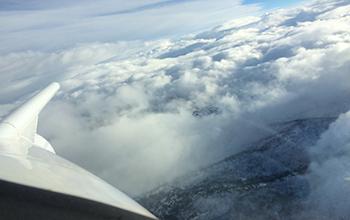Cloud seeding for snow: Does it work? Scientists report first quantifiable observations

View from the cockpit of the King Air during a research flight over the Payette Mountains. Credit: Jeff French
For the first time, scientists have obtained direct, quantifiable observations of cloud seeding for increased snowfall — from the growth of ice crystals, through the processes that occur in clouds, to the eventual snowfall.
The National Science Foundation (NSF)-supported project, dubbed SNOWIE (Seeded and Natural Orographic Wintertime Clouds — the Idaho Experiment), took place from Jan. 7 to March 17, 2017, in and near Idaho's Payette Basin, located approximately 50 miles north of Boise.
The research was conducted in concert with the Boise-based Idaho Power Company, which provides a large percentage of its electrical power through hydroelectric dams.
Throughout the Western U.S. and in other semi-arid mountain regions across the globe, water supplies are maintained primarily through snowmelt. Growing human populations place a higher demand on water, while warmer winters and earlier springs reduce snowpack and water supplies. Water managers see cloud seeding as a potential way of increasing winter snowfall.
“But no one has had a comprehensive set of observations of what really happens after you seed a cloud,” says Jeff French, an atmospheric scientist at the University of Wyoming (UW) and SNOWIE principal investigator. “There have only been hypotheses. There have never been observations that show all the steps in cloud seeding.”
French is the lead author of a paper reporting the results, published in today's issue of the journal Proceedings of the National Academy of Sciences. Co-authors of the paper are affiliated with the University of Colorado- Boulder, University of Illinois at Urbana-Champaign, the National Center for Atmospheric Research, and the Idaho Power Company.
French credited modern technology with making the detailed cloud-seeding observations possible, citing the use of ground-based radar as well as radar on UW's King Air research aircraft and multiple flights over the mountains near Boise.
“This research shows that modern tools can be applied to longstanding scientific questions,” says Nick Anderson, a program director in NSF's Division of Atmospheric and Geospace Sciences, which funded the study. “We now have direct observations that seeding of certain clouds follows a pathway first theorized in the mid-20th century.”
Cloud seeding stimulates snowfall by releasing silver iodide into clouds from the air or from ground-based generators. In the SNOWIE project, an aircraft supported by the Idaho Power Company released the silver iodide, while the UW King Air took measurements to monitor the silver iodide's impact.
Cloud seeding occurred during 21 flights. During three flights, Idaho Power was forced to suspend cloud seeding because there was already so much snow in the Idaho mountains, French says. The UW King Air made 24 flights lasting four to six hours each, the last three monitoring natural snowfall activity.
Numerical modeling of precipitation measurements was conducted using a supercomputer nicknamed Cheyenne at the NCAR-Wyoming Supercomputing Center.
The numerical models simulated clouds and snowfall over the Payette Basin, as created both in natural storms and with cloud seeding. The models are enabling researchers to study storms where measurements have not been obtained in the field.
“In the long-term, we will be able to answer questions about how effective cloud seeding is, and what conditions may be needed,” says French. “Water managers and state and federal agencies can make decisions about whether cloud seeding is a viable option to add additional water to supplies from snowpack in the mountains.”
Media Contact
All latest news from the category: Earth Sciences
Earth Sciences (also referred to as Geosciences), which deals with basic issues surrounding our planet, plays a vital role in the area of energy and raw materials supply.
Earth Sciences comprises subjects such as geology, geography, geological informatics, paleontology, mineralogy, petrography, crystallography, geophysics, geodesy, glaciology, cartography, photogrammetry, meteorology and seismology, early-warning systems, earthquake research and polar research.
Newest articles

A ‘language’ for ML models to predict nanopore properties
A large number of 2D materials like graphene can have nanopores – small holes formed by missing atoms through which foreign substances can pass. The properties of these nanopores dictate many…

Clinically validated, wearable ultrasound patch
… for continuous blood pressure monitoring. A team of researchers at the University of California San Diego has developed a new and improved wearable ultrasound patch for continuous and noninvasive…

A new puzzle piece for string theory research
Dr. Ksenia Fedosova from the Cluster of Excellence Mathematics Münster, along with an international research team, has proven a conjecture in string theory that physicists had proposed regarding certain equations….



